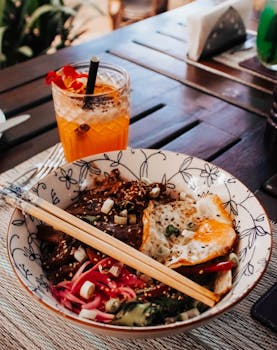Anúncios
Food design is an emerging field that combines culinary arts, aesthetics, and functionality. It focuses on creating food experiences that delight the senses while ensuring the meal is practical and enjoyable.
The goal of food design is to elevate dining experiences beyond just taste. It encompasses elements of visual presentation, cultural significance, and sustainable practices. By doing so, it appeals to a wider audience and creates memorable moments.
As people become more aware of their food choices, the need for thoughtful design in food grows. This article explores food design’s various components, its importance, and how it shapes our culinary landscape.
What is Food Design?
Food design is the art and science of creating food experiences through innovative cooking techniques and aesthetics. It blends culinary skills with aspects of design, such as color, texture, and presentation.
In essence, food design enhances the visual and sensory appeal of meals. It is not limited to fine dining; it applies to everyday meals, snacks, and even packaging.
Anúncios
A key aspect of food design is understanding the relationship between food and culture. Different cultures have unique ways of preparing and presenting food, which influence how it is received by diners.
Additionally, food design takes into account the nutritional value and sustainability of ingredients. This approach promotes health while minimizing environmental impact, appealing to modern consumers.
Overall, food design is about creating a more engaging and wholesome food experience. As interest in food culture grows, the demand for innovative food design continues to rise.
Anúncios
The Importance of Aesthetics in Food Design
Aesthetics play a crucial role in food design, as they affect our perception and enjoyment of food. A visually appealing meal can enhance the dining experience and stimulate appetite.
Research shows that consumers often associate beautiful presentations with higher quality and taste. When food looks good, people are more likely to enjoy it and share it on social media.
Colors, shapes, and textures all contribute to food aesthetics. Bright colors may evoke freshness, while unique shapes can intrigue diners and create memorable experiences.
Moreover, the arrangement of food on a plate enhances its visual appeal. Thoughtful plating involves balancing elements and creating focal points that guide the eye.
In short, aesthetics in food design matters greatly. It transforms ordinary meals into extraordinary experiences and cultivates a deeper appreciation for culinary arts.
Cultural Influences in Food Design
Cultural background significantly influences food design, shaping approaches to ingredients, preparation, and presentation. Each culture offers distinct flavors, cooking methods, and dining rituals.
For example, Japanese cuisine emphasizes minimalism and harmony in presentation, focusing on seasonal ingredients. In contrast, Mediterranean cuisine often showcases vibrant colors and bold flavors.
Furthermore, cultural traditions dictate how food is served. Some cultures prioritize communal dining, while others focus on individual servings. These practices impact how food is designed and consumed.
Incorporating cultural elements into food design fosters inclusivity and diversity. It invites people to explore different cuisines and appreciate the rich tapestry of global food practices.
Ultimately, cultural influences enrich food design by adding depth and meaning. They remind us that food is not just sustenance but a reflection of shared history and values.
The Role of Sustainability in Food Design
Sustainability is a vital component of modern food design. As environmental concerns rise, designers focus on creating meals that minimize ecological impact and promote ethical practices.
Using local and seasonal ingredients is one way to enhance sustainability. This not only reduces carbon footprint, but also supports local economies and encourages freshness in meals.
Additionally, sustainable food design emphasizes reducing waste. This can involve clever use of food scraps or innovative packaging methods that minimize environmental harm.
Moreover, responsible sourcing of ingredients plays a significant role in sustainability. Consumers increasingly seek out brands that prioritize ethical practices and transparency in their food chains.
In conclusion, sustainability shapes food design by encouraging practices that respect the environment. It ensures that future generations can continue to enjoy diverse and flavorful culinary experiences.
The Science of Flavor Pairing
Flavor pairing is a fascinating aspect of food design. Understanding how different ingredients interact can lead to innovative and surprising culinary creations.
Various scientific principles guide flavor pairing, such as complementary and contrasting flavors. Palates can be delighted by unique combinations, enhancing enjoyment and interest in dishes.
For instance, sweet and salty flavors often complement each other, creating balanced and satisfying bites. Meanwhile, contrasting textures can elevate a dish by adding depth and excitement.
Experimentation is vital in flavor pairing. Chefs and food designers often explore unexpected combinations, discovering new flavor profiles that push culinary boundaries.
Ultimately, the science of flavor pairing enriches food design by encouraging creativity and innovation. It invites both chefs and diners to experience food in novel and exciting ways.
Food Design in the Context of Technology
Technology increasingly influences food design, revolutionizing how food is prepared, presented, and consumed. Innovations in cooking techniques and tools allow chefs to explore new culinary possibilities.
For example, molecular gastronomy utilizes scientific techniques to manipulate food textures and flavors. This approach creates visually stunning and unique dining experiences that captivate diners.
Additionally, technology plays a significant role in food presentation. Digital platforms enable chefs to share their work with wider audiences, inspiring new trends and ideas in food design.
Furthermore, advancements in food production and preservation contribute to better ingredient accessibility. Chefs can obtain high-quality ingredients more easily, enhancing the overall dining experience.
In summary, technology shapes food design by introducing new methods, tools, and ideas. It empowers chefs to innovate while expanding culinary horizons for consumers.
Conclusion
Understanding food design is essential for appreciating the intricate relationship between food and experience. This field combines aesthetics, culture, sustainability, flavor, and technology to create engaging meals.
As culinary practices continue to evolve, so does the importance of thoughtful food design. It enhances everyday meals while celebrating diverse traditions and innovative techniques.
Ultimately, food design fosters greater appreciation for the art of cooking. By recognizing its significance, we enrich our culinary journeys and create meaningful connections through food.
| Aspect of Food Design | Description |
|---|---|
| Aesthetics | Focuses on the visual presentation and appeal of food. |
| Cultural Influences | Incorporates diverse culinary traditions and practices. |
| Sustainability | Emphasizes ethical sourcing and reducing environmental impact. |
| Flavor Pairing | Explores the interactions between different ingredients. |
| Technology | Utilizes innovations to enhance cooking and presentation. |
- Elevates dining experiences beyond taste.
- Fosters inclusivity through cultural exploration.
- Promotes sustainability and responsible sourcing practices.
- Encourages innovation in flavor pairing and preparation techniques.
- Utilizes technology to enhance creativity and accessibility.



